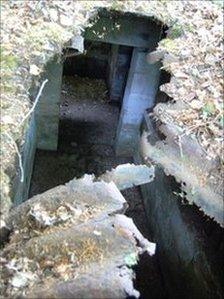Secret wartime bunker near Cardiff opened to public
- Published

The concrete bunker had become very overgrown in the years since the war
While the role of the Home Guard during World War II has been widely celebrated, very little is known of their counterparts in the Auxiliary Units, who would have been Britain's last line of defence in the event of a Nazi invasion.
The units, dubbed "Churchill's Secret Army", were set up to relay vital information about enemy movements and help mount counter-attacks as Britain braced itself for occupation.
Now Forestry Commission Wales has unearthed a bunker which would have provided a secret hideout, had the troops needed it.
The concrete structure nestled in the Coed Coesau-Whips Woodland near Rudry, between Caerphilly and Cardiff, has been overgrown for 60 years, but even then it would have been hard to spot.
It has been cleaned out, and made to look as it would have done in wartime, with the help of historians from the Coleshill Auxiliary Research Team (CART), and a newspaper appeal for secrets held amongst locals for over half a century.
CART founder Tom Sykes said, "Preserving sites like this is really important as they allow the public to see just what life would have been like for members of Churchill's Auxiliary Units.
"If Hitler had invaded, up to eight men would have lived in bases similar to this and they would have survived off the land and their rations.
The Coed Coesau-Whips site was chosen for its strategic advantages.
Its elevation gave a view over south Wales and the Bristol Channel.
It was also close enough to the heavy industry of the south Wales valleys to act as a base for sabotage missions, and was rural enough for men to have scavenged for food and live anonymously for months at a time without attracting attention.
The bunker's concrete facade was camouflaged in soil and undergrowth and was designed to slide away like a sunroof.
It would have revealed basic living quarters which could easily have been mistaken for the den of a vagrant if discovered.
However, behind another false door was an inner chamber which would have hidden state-of-the-art radio communications, maps and reconnaissance photos, and be a control centre for hundreds of operatives working in the field.
To make it safe for visitors, Forestry Commission Wales has had to clear away all the accumulated foliage and rubbish, as well as build a path from the road and put up fences to prevent people falling into the camouflaged bunker.
Ranger at the forest, Emma Louise Felkin, said, "We've always said that our forests have an important role to play in providing a whole range of social, environmental and economic benefits, but this bunker reminds us of a time when they were important for a totally different reason.
"It's right that we remember our past and we were delighted that CART was able to help us preserve this fascinating part of our heritage."
- Published23 January 2011
- Published23 July 2010